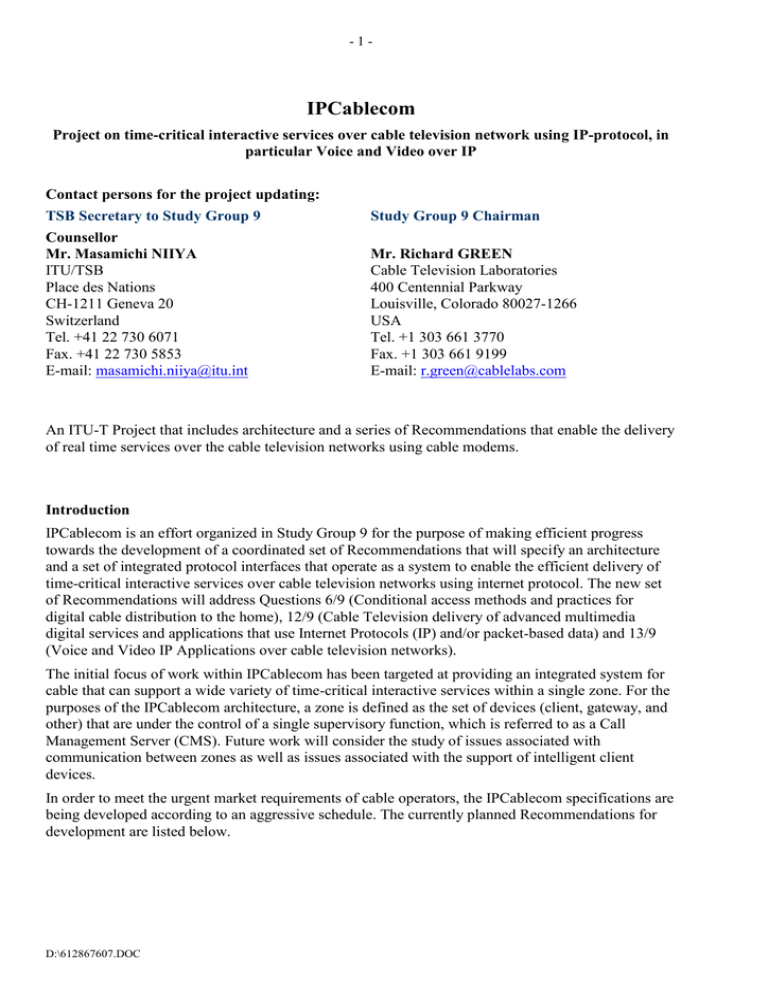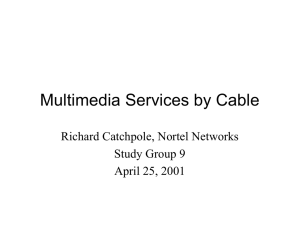IPCablecom
advertisement

-1- IPCablecom Project on time-critical interactive services over cable television network using IP-protocol, in particular Voice and Video over IP Contact persons for the project updating: TSB Secretary to Study Group 9 Study Group 9 Chairman Counsellor Mr. Masamichi NIIYA ITU/TSB Place des Nations CH-1211 Geneva 20 Switzerland Tel. +41 22 730 6071 Fax. +41 22 730 5853 E-mail: masamichi.niiya@itu.int Mr. Richard GREEN Cable Television Laboratories 400 Centennial Parkway Louisville, Colorado 80027-1266 USA Tel. +1 303 661 3770 Fax. +1 303 661 9199 E-mail: r.green@cablelabs.com An ITU-T Project that includes architecture and a series of Recommendations that enable the delivery of real time services over the cable television networks using cable modems. Introduction IPCablecom is an effort organized in Study Group 9 for the purpose of making efficient progress towards the development of a coordinated set of Recommendations that will specify an architecture and a set of integrated protocol interfaces that operate as a system to enable the efficient delivery of time-critical interactive services over cable television networks using internet protocol. The new set of Recommendations will address Questions 6/9 (Conditional access methods and practices for digital cable distribution to the home), 12/9 (Cable Television delivery of advanced multimedia digital services and applications that use Internet Protocols (IP) and/or packet-based data) and 13/9 (Voice and Video IP Applications over cable television networks). The initial focus of work within IPCablecom has been targeted at providing an integrated system for cable that can support a wide variety of time-critical interactive services within a single zone. For the purposes of the IPCablecom architecture, a zone is defined as the set of devices (client, gateway, and other) that are under the control of a single supervisory function, which is referred to as a Call Management Server (CMS). Future work will consider the study of issues associated with communication between zones as well as issues associated with the support of intelligent client devices. In order to meet the urgent market requirements of cable operators, the IPCablecom specifications are being developed according to an aggressive schedule. The currently planned Recommendations for development are listed below. D:\612867607.DOC -2- Background In their conversion to digital television, cable television systems in many countries are also provisioning very high-speed bi-directional data facilities to support, among other payloads, those utilizing Internet Protocol (IP). These facilities can also be used to supply other digital services to the home, based on packet-data, exploiting the broadband capacity provided by hybrid fibre/coaxial (HFC) digital cable television systems, and interconnecting local, geographically distinct digital cable television systems through direct connections or managed backbones. The envisaged range of packet-based data services to be provided encompasses those services and applications that are based on the use of IP. The technology considered for the delivery of those packet-based data services over the cable television infrastructure resorts to the use of the relevant transmission protocols, including Internet Protocols (IP) and enhancements thereof. Many cable television operators are upgrading their facilities to provide two-way capability, and are using this capability to provide high-speed IP data and other various multimedia services. These operators want to expand the capability of this delivery platform to include bi-directional voice communication and other time-critical services. Based on Recommendation J.112, “Transmission Systems for Interactive Cable Television Services”, Voice over IP/Video over IP services over IP-based cable television networks are expected to be available to the market soon. New Recommendations for these applications are strongly required to meet the demand of new services in a timely manner. According to the draft Recommendation J.160 (J.arch), the IPCablecom architecture at a very high level has to connect with three networks: HFC access network, managed IP network and PSTN. System architecture should describe the specifications of the functional components and define the interfaces between these networks and IP-based cable television networks. The reference architecture for IPCablecom is shown in Fig.1. Call Management Server Embedded MTA Client MTA Cable Modem HFC access network (CMS) CMTS Media Gateway Controller (MGC) HFC access network CMTS Signaling Gateway (SG) OSS Back Office Servers and Applications Figure 1. IPCablecom Reference Architecture D:\612867607.DOC PSTN Media Gateway (MG) Embedded MTA Client Cable Modem Announcement Controller (ANC) Announcement Player (ANP) Managed IP Network MTA Announcement Server - Ticket Granting Server (TGS) - DHCP Servers - DNS Servers - TFTP or HTTP Servers - SYSLOG Server - Record Keeping Server (RKS) - Provisioning Server -3- The Cable Modem HFC access network provides high-speed, reliable, and secure transport between the customer premise and the cable headend. This access network may provide all Cable Modem capabilities including Quality of Service. The Cable Modem HFC access network includes the following functional components: the Cable Modem (CM), Multi-media Terminal Adapter (MTA), and the Cable Modem Termination System (CMTS). The Managed IP network serves several functions. First, it provides interconnection between the basic IPCablecom functional components responsible for signaling, media, provisioning, and quality of service establishment. In addition, the managed IP network provides long-haul IP connectivity between other Managed IP and Cable Modem HFC networks. The Managed IP network includes the following functional components: Call Management Server (CMS), Announcement Server (ANS), several Operational Support System (OSS) back-office servers, Signaling Gateway (SG), Media Gateway (MG), and Media Gateway Controller (MGC). Both the Signalling Gateway (SG) and the Media Gateway (MG) provide connectivity between the managed IP network and PSTN. An IPCablecom zone consists of the set of MTAs in one or more Cable Modem HFC access networks that are managed by a single functional CMS as shown in Figure 2. Interfaces between functional components within a single zone are defined in the IPCablecom specifications. Interfaces between zones (e.g., CMS-CMS) have not been defined and will be addressed in future phases of the IPCablecom architecture. Administrative Domain 1 Administrative Domain 2 PSTN Gateway CMS PSTN V CMS MSO A Zone 1 MSO B Zone 3 Managed IP Backbone PSTN Gateway CMS PSTN PSTN Gateways V PSTN MSO A Zone 2 V MSO C Zone 4 Administrative Domain 3 Figure 2. Zones and Administrative Domains An IPCablecom domain is made up of one or more IPCablecom zones that are operated and managed by a single administrative entity. An IPCablecom domain may also be referred to as an administrative domain. Interfaces between domains have not been defined in IPCablecom and are for further study. D:\612867607.DOC -4- Currently planned IPCablecom Recommendations The table below lists the set of IPCablecom Recommendations currently planned for development, in order to meet the urgent market requirements of cable operators, along with the current status of each document: IPCablecom Rec. Rec. Name Status Recommendation Scope J.160 Architecture Framework Approved Defines architecture framework for IPCablecom networks including all major system components and network interfaces necessary for delivery of IPCablecom services. J.161 Audio/Video Codecs Approved Defines the audio and video codecs necessary to provide the highest quality and the most resource-efficient service delivery to the customer. Also specifies the performance required in client devices to support future IPCableCom codecs. and describes suggested methodology for optimal network support for codecs. J.163 Dynamic Quality-ofService Approved Defines the QoS Architecture for the “Access” portion of the PacketCable network, provided to requesting applications on a per-flow basis. The access portion of the network is defined to be between the Multi-media Terminal Adapter (MTA) and the Cable Modem Termination System (CMTS). The method of QoS allocation over the backbone is unspecified in this document. J.162 NetworkBased Call Signaling Approved Defines a profile of the Media Gateway Control Protocol (MGCP) for IPCablecom embedded clients, referred to as the Network-based Call Signaling (NCS) protocol. MGCP is a call signaling protocol for use in a centralized call control architecture, and assumes relatively simple client devices. J.164 Event Messages Approved Defines the concept of Event Messages used to collect usage for the purposes of billing within the IPCablecom architecture. J.165 Internet Signaling Transport Protocol (ISTP) Approved Defines the Internet Signaling Transport Protocol (ISTP) for IPCablecom PSTN Signaling Gateways. ISTP is a protocol that provides a J.168 MTA MIB Approved Defines the MIB module which supplies the basic management objects for the MTA Device. J.169 NCS MIB Approved Defines the MIB module which supplies the basic management object for the NCS protocol J.166 MIBs Framework Approved Describes the framework in which IPCablecom MIBs (Management Information Base) are defined. It provides information on the signaling interconnection service between the IPCablecom network control elements (Call Management Server and Media Gateway Controller) and the PSTN C7 Signaling network through the C7 Signaling Gateway. management requirements of IPCablecom specified devices and functions, and how these requirements are supported in the MIB. It is intended to support and complement the actual MIB documents, which are issued separately. J.167 MTA Device D:\612867607.DOC Approved Defines the protocol mechanisms for provisioning of an IPCablecom -5IPCablecom Rec. Rec. Name Status Provisioning Recommendation Scope embedded-MTA device by a single provisioning and network management provider. J.170 Security Approved Defines the Security architecture, protocols, algorithms, associated functional requirements and any technological requirements that can provide for the security of the system for the IPCablecom network. J.171 PSTN Gateway Call Signaling Approved Defines a trunking gateway control protocol (TGCP) for use in a centralized call control architecture that assumes relatively simple endpoint devices. TGCP is designed to meet the protocol requirements for the Media Gateway Controller to Media Gateway interface defined in the IPCablecom architecture. J.172 Management Event Mechanism Approved Defines the management Event Mechanism that IPCablecom elements can use to report asynchronous events that indicate malfunction situations and notifcation about improtnt non-fault situation J.173(pls) Embedded MTA Device Specification Approved Specifies minimum device requirements for embedded multimedia terminal adapters in the areas of physical interfaces, power requirements, processing capabilities and protocol support. jJ.174 InterdomainQ uality of Service Approved Defines an architectural model for end-to-end Quality of Service for IPCablecom Inter-and Intra-Domain environments.. Relationships Cooperation required to be established with ITU-T Study Groups 11, 13, 15, 16 and ITU-R SG6, and other relevant standard organizations. D:\612867607.DOC



